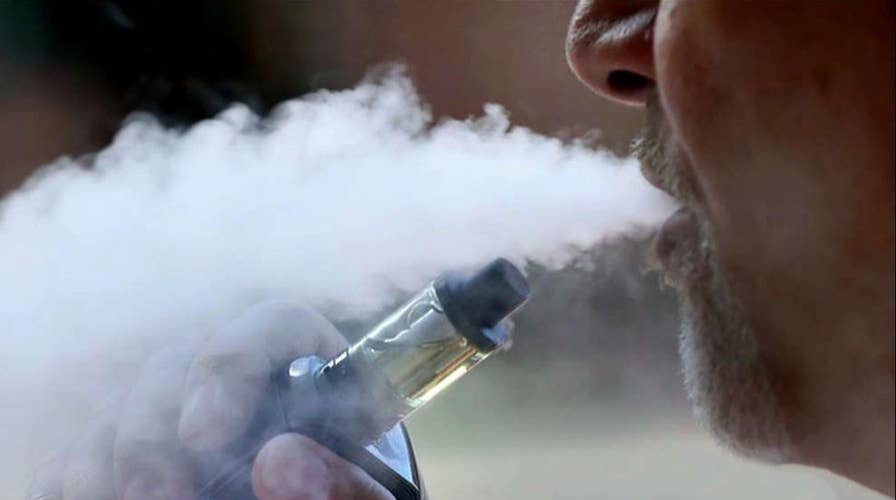State health departments report 18 vaping-related fatalities in 15 states
Centers for Disease Control and Prevention reports more than 800 people have gotten sick after vaping; Jonathan Serrie reports from Atlanta.
Doctors from the Mayo Clinic analyzed lung tissue samples from patients who became ill after vaping and determined the damage to their lungs resembles chemical burns, such as those from mustard gas, a chemical agent used during World War I.
Samples from 17 patients – 13 men and four women – were studied. All had a history of vaping nicotine or marijuana products; about 70 percent had a history of the latter. The findings were published Wednesday in The New England Journal of Medicine.
“These injuries most closely resemble toxic chemical fume injuries, which are thankfully pretty uncommon, but we have certainly seen a similar pattern before in those situations. An industrial accident with a toxic chemical spill, for example, or exposure to poisonous gas,” Dr. Brandon T. Larsen, a surgical pathologist at the Mayo Clinic in Scottsdale, Ariz., told Fox News.
Larsen emphasized he’s never seen anything like this with cigarette smoking or traditional marijuana cigarette smoking.
KIDS IN KANSAS ARE EATING VAPING CARTRIDGES, DRINKING LIQUID NICOTINE, POISON CONTROL CENTER SAYS

(AP Photo/Samantha Maldonado)
Larsen, speaking to The New York Times, also paralleled the tissue damage to mustard gas exposure.
The Centers for Disease Control and Prevention (CDC) on Thursday announced the number of vaping-linked lung illnesses had increased to 1,080 cases across 48 states and one U.S. territory. At least 18 people have died in 15 states, though Connecticut officials announced the state's first death that was not included in the CDC's total, bringing the count to at least 19. The federal health agency is still investigating what’s behind the growing number of illnesses but has yet to identify a single product, chemical or additive as the culprit.
In late September, the CDC said many who were sickened reported vaping products that contained THC, the psychoactive ingredient in marijuana. Health officials in some states are eyeing vitamin E acetate, or vitamin E oil, as a potential cause of the illnesses, at least in those who vaped THC. Additionally, a recent Washington Post investigation concluded that the illnesses may be linked to black-market vaping products, some of which are allegedly cut with the agent.
But Larsen said he and the other Mayo Clinic doctors who analyzed the lung tissue samples “did not see significant oil accumulation in the lung.”
“Many cases may not have been recognized before, and I don’t believe this is a new problem, although the recent surge certainly suggests that we need to be more vigilant than ever and expand our efforts to determine what the real cause is."
In the report, doctors wrote that “foamy macrophages and pneumocyte vacuolization were seen in all cases.” Macrophages are large cells of the immune system that recognize dead or damaged cells and destroy them. Larsen told the Times the foamy appearance is “characteristic of chemical injuries.”
However, “that does not necessarily eliminate the possibility that oils may be playing a role” in the illnesses, he told Fox News.
“Our findings suggest that, whatever the culprit is, the type of injury is a toxic chemical injury, which could be caused by a wide variety of substances. What it means is that we need to keep our search broad, and not simply look at lipids,” such as waxes and oils.
“We need to analyze vape liquids, patient samples, and so forth for all potential substances and chemicals that may be injuring the lungs,” he added.
CLICK HERE FOR THE ALL-NEW FOXBUSINESS.COM
When asked if the recent surge in vaping-linked lung illnesses is potentially connected to a “bad batch” of nicotine or marijuana-containing products, Larsen said more research is needed.
“I think it’s too early to tell [if a] recent addition of some toxic substance to the vape supply explains the recent surge,” he said. In fact, two patients in the study “came to clinical attention several years ago, well before the current crisis," he noted.
“Many cases may not have been recognized before, and I don’t believe this is a new problem, although the recent surge certainly suggests that we need to be more vigilant than ever and expand our efforts to determine what the real cause is,” he said.




















